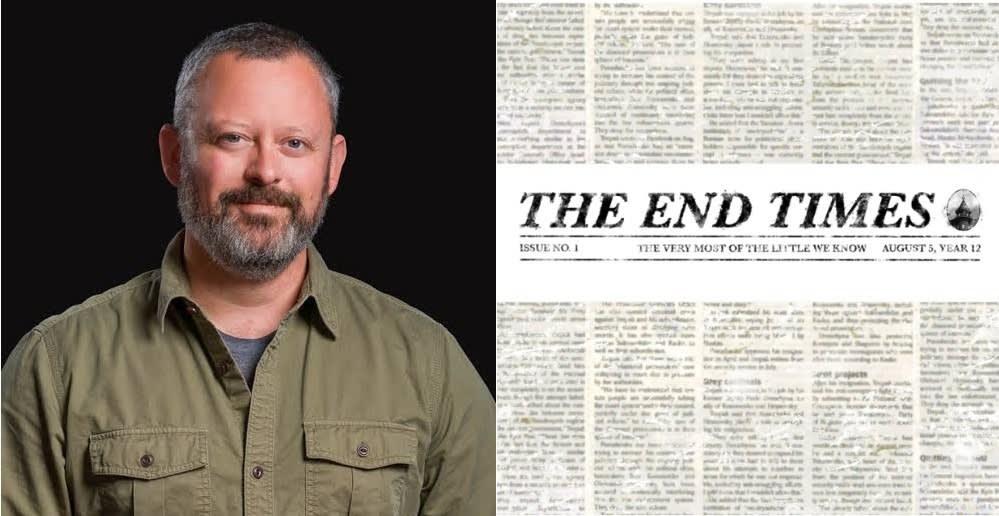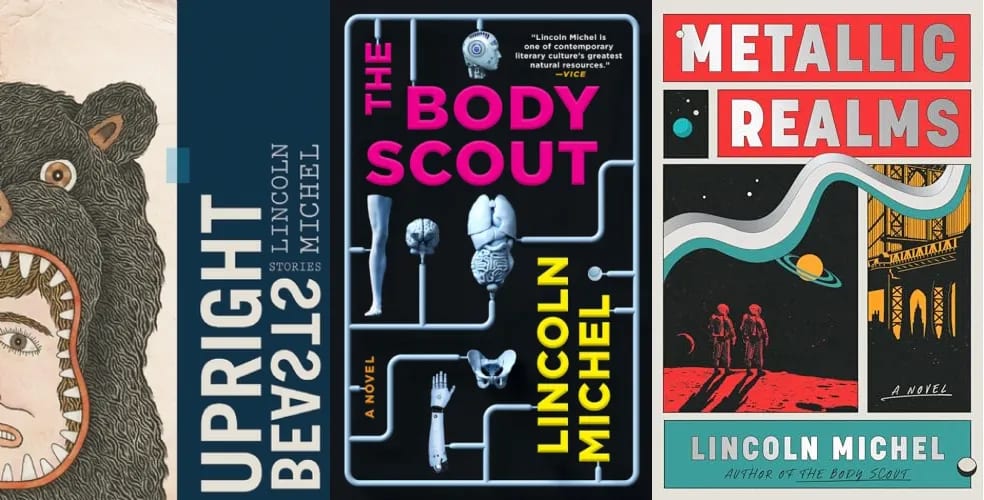If you’re a regular reader of this newsletter, then you know I’m a sucker for inventive structures and forms. So, my ears perked up when I heard Benjamin Percy was going to serialize his next novel in the form of a newspaper. The End Times will be serialized over the course of a year in both print and digital forms, and will include contributions from the legendary Stephen King. Benjamin Percy is jack-of-all-trades author who writes in many genres and mediums—but since this is a craft-focused newsletter, I’ll highlight his excellent collection of craft essays Thrill Me.
I spoke to Percy over email about writing across mediums and genres, working with Stephen King, and the appeal of real things in the digital age.
My first question is perhaps an obvious one: In the internet age—when we increasingly spend our hours on social media apps and traditional newspapers seem to be dying—why did you decide to write a novel in the form of a physical newspaper? (Note to readers: there will be a digital version too.)
My first response is going to make me sound like the grumpy old man I am. I’m sick of screens. Not just for the obvious reasons (which you can fill in yourself)—but the ephemerality of everything. Books and records and DVDs on a shelf make me happy, because they are companions. I develop a connection with them, a charge almost like with a battery. I can pick up physical media and remember where I lived and where I was in my career and what I was going through personally when I first read or listened or watched a title.
I still read print newspapers and magazines. I was on a plane the other month, rustling through the New York Times Book Review, and the person sitting next to me said, “You don’t see too many of them anymore.” It took me a second to process what they were talking about. A newspaper. A physical newspaper. It was an antiquated novelty? I’ve had people make similar remarks when they observe me reading novels in public. I can’t help but increasingly feel that I am in the horse-and-buggy business, so I might as well lean into it.
I’m no Magic 8 Ball, but I suspect that with the rise of A.I., people will seek out more real things. A concert. A play. An open mic. A shadow puppet show. Something made with hands and voices. That’s my desire anyway, and maybe I’m not alone, since people have been responding so positively to The End Times.
Let’s all get our fingers stained with ink.
Here’s the second reason. I love experiments. That’s why I’ve been directing short films over the past two years. I could have just written another novel, but this felt like a fun opportunity to stretch myself creatively and push back against storytelling forms and publishing norms. I’ve been drawn to epistolary novels since I first read Dracula as a middle-schooler. And when you shatter people’s expectations of what a story can be, you make them more emotionally vulnerable.
I really love the idea of a unique physical object, like a novel-as-newspaper that includes—as you told me—comic strips in each issue. It’s such a fun idea, and I think literature is missing a sense of fun these days… Can you talk a little about how the project came about, including the design and printing process? Are you drawing the comics yourself?
I live in a small town: Northfield, Minnesota. Our weekly newspaper is The Northfield News. And it’s almost entirely written by one person. They go to the city council meetings, the high school wrestling matches. They run the obituaries and feature interviews with church organists who are retiring after fifty years. They make announcements about upcoming events both big (a lecture at Carleton College by a Nobel Prize-winner) and small (a meeting of local weavers). I love it. I read it cover to cover. It brings me a weird kind of peace (given the insanity of national and global news right now) and it’s also given me a sense of place (and I’m someone who has moved constantly until settling here thirteen years ago, the longest I’ve lived anywhere). So I was inspired by that.
I’m also inspired by the current attacks on journalism. This is a story that celebrates the power of reporting. To educate, entertain, bring a community together, even save lives. A woman finds purpose—in a post-apocalyptic America—when she stumbles upon an old printing press and launches a newspaper: The End Times. The tagline is “The very most of the little we know.” At first there are only a few copies. And one voice—her own. But over time she recruits others to join her, and the paper grows bigger and more complicated. The story has the overall vibe of Station Eleven meets Our Town.
My agent sniffed around New York and all the big presses were allergic to the logistical nightmare of publishing a newspaper. I knew I needed a scrappy partner on this who wouldn’t be afraid to get their hands a little dirty. I’ve been watching Bad Hand Books carefully over the past few years. They’re a small publisher doing big things. Putting out books by folks like Mike Mignola, Bracken MacLeod, Clay Chapman, Laird Barron. Novels, graphic novels, novellas. They’re winning Bram Stokers. They just made a distribution deal and now have a highway to every bookstore in the country. I reached out to Doug Murano, the editor, and asked if he’d be willing to take a swing on something weird and challenging. He was all in. And—here’s the really fun part—his mother-in-law owns a small-town newspaper. The Waubay Clipper, a paper that publishes weekly out of South Dakota. We’re going to use their facilities, and Doug’s mother-in-law is helping with the design/layout. This is all very grassroots. Doug is stamping and mailing these newspapers himself, so please support him and small presses by subscribing! After a year, we’re going to collect all the editions and put out a book, but it will have a special design to retain the feel of a newspaper.
As for the comics, I’m writing them, but my good pal Matt Bowers is drawing them (in the style of woodprints, so they look like they can be reproduced on a printing press). He also designed the title dress and the maps.
You recently announced that the king, Stephen King, is contributing to the project. What can you say about that?
Stephen King is not only devilishly talented and monstrously prolific…he’s a really nice dude. And very grounded and approachable. We’ve been in touch for about a decade. He’s kindly blurbed a few of my novels. I interviewed him on stage.
I really hesitated to ask him to join forces on this, because…he’s freaking Stephen King. Like, not only my hero, but someone who’s probably getting bugged by five million other people a day.
But…I don’t know…I finally said fuck it. I shot off an email. I told him—obviously—no pressure. But he responded immediately and positively. So how awesome is that?
This wasn’t a random ask. I read The Green Mile in its serialized form. Carrie has epistolary elements. He’s had wild experiments—like Riding the Bullet and The Plant. And…The End Times basically takes place in the same universe as The Stand.
So yeah, we’re emailing back and forth. He’s sending me both ideas and articles. It’s so fucking cool to be able to riff with him. What a generous guy.
And in the same spirit of generosity, for every digital subscription over 500, we’ll be donating one dollar to the ACLU.
You’re a writer who works in many different formats. You’ve written not only novels and short stories, but also comic books, screenplays, and podcast scripts. What draws you to write in these different forms? And what unique challenges or opportunities has the serialized newspaper format presented?
Writing across mediums and genres not only keeps me from getting bored, it forces me to constantly expand my storytelling arsenal. Writing literary fiction made me a better horror writer. Writing comics makes me a better novelist. Writing novels made me a better scripter of audio dramas. I could go on, but I hope that I’ll never find myself in an aesthetic rut, so long as I keep making things new and difficult for myself.
Here’s one of the things you can pronounce with the newspaper format: suspense. Because there’s a month’s wait between big events. And because you know The End Times lasts a year, the calendar is like a countdown to detonation.
Interiority is a bit of a challenge. The paper is edited and (mostly) written by a woman named Mary Poole. At first she feels like she’s writing more for herself, so she’s a bit more reckless with what she puts on paper—but as the paper grows in popularity and more and more people begin to rely on it, she has to pull back her personal story to give way to the community’s narrative.
Did your time writing Marvel and DC comics inform your writing on this project? I remember hearing you talk about the differences between novel and comic book narratives, where B plots and C plots are seeded into the narrative to pave the way for future issues.
Absolutely. The serialized storytelling. The seeding of emotional and narrative arcs. The turnstile of A,B,C,D plots. A lot of what I’ve learned from Marvel and DC can be found in The End Times.
I could write a book in response to your question. And I’ve written a few pieces for Poets & Writers on the subject. But here’s a quick and dirty response that tackles just one difference.
When you’re writing novels, you know that you’re supposed to be constantly contributing to plot, character, and theme—but writing for comics forces you to. And forces you to do it efficiently and muscularly. Because you don’t have 300 or 1,000 pages. You have twenty pages every month. And visual storytelling makes it baldly evident when your story is stalling.
Imagine a scene in which a couple sits down at a kitchen table…and one cracks a beer while the other sips at some tea…and they have a conversation that grows tense…and eventually someone throws a glass and walks out. Maybe that took you five or ten pages to write. But try paneling it. If on Page 1, Panel 1, your characters enter the kitchen…and if on Page 5, Panel 5, they’re still sitting around, sipping at their drinks…you’ve got a problem. That’s a boring comic book.
Think of it in terms of vectors. The vertical vector is emotional. Literary novelists are great at that. The horizontal vector is plot progression, narrative moment, story beats, however you want to think about it. Literary novelists are generally not great at that. So they’re mostly inhabiting the vertical vector.
As an exercise, I’ve asked students to panel their stories. And they’ll recognize that they have, say, 14 pages of vertical fill and 2 pages of horizontal movement in their chapter. Finding a story space that evens the vectors out can sometimes serve your story best.
Flip the model and apply it to comics writing. There’s a reason that Joker, Batman, and Robin won’t shut up when they’re fighting on a rooftop. They’re exploring the emotional, thematic, and societal stakes of the story—all while throwing a punch, chucking a grappling hook. The vertical vector is woven through the horizontal.
Now I’m making stories sound like math, which is boring.
Serialized novels are rare these days, but obviously they were the default in the 19th and early 20th century. There has been a lot of chatter about serialization making a comeback today, through things like Substack and Patreon. Do you think the time is right for serialization to rise again?
Could be. I suppose it allows for longer-form storytelling while catering to shorter attention spans. But trying to predict markets is usually something that annoying Hollywood producers do. I’m not that savvy. I’m just trying to tell the best story I can—through an experimental form—and hopefully the fun I’m having will be infections and carry over to the reader.
The End Times is a post-apocalyptic novel. You’re a writer who has written in many different genres and subgenres from realism to science fiction to werewolf horror. I’m always curious how writers approach the question of genre. Is genre something you think about while writing?
When I’m working for Marvel or DC, when I’m writing a character like Wolverine or Batman or Hulk or Punisher, I have to honor their legacy (which sometimes spans decades) while also putting a unique mark on the franchise. I suppose you could say my approach to genre is similar. I’m recognizing what’s come before me—tropes and conventions—and I know that readers will come to my story because they want some sniff of familiarity. But I’m not just going to do Ray Bradbury or Richard Matheson karaoke. I’m going to push boundaries and revise elements to give them something new and hopefully striking and memorable.
My new novel Metallic Realms is out in stores! Reviews have called the book “Brilliant” (Esquire), “riveting” (Publishers Weekly), “hilariously clever” (Elle), “a total blast” (Chicago Tribune), “unrelentingly smart and inventive” (Locus), and “just plain wonderful” (Booklist). My previous books are the science fiction noir novel The Body Scout and the genre-bending story collection Upright Beasts. If you enjoy this newsletter, perhaps you’ll enjoy one or more of those books too.
.png)






